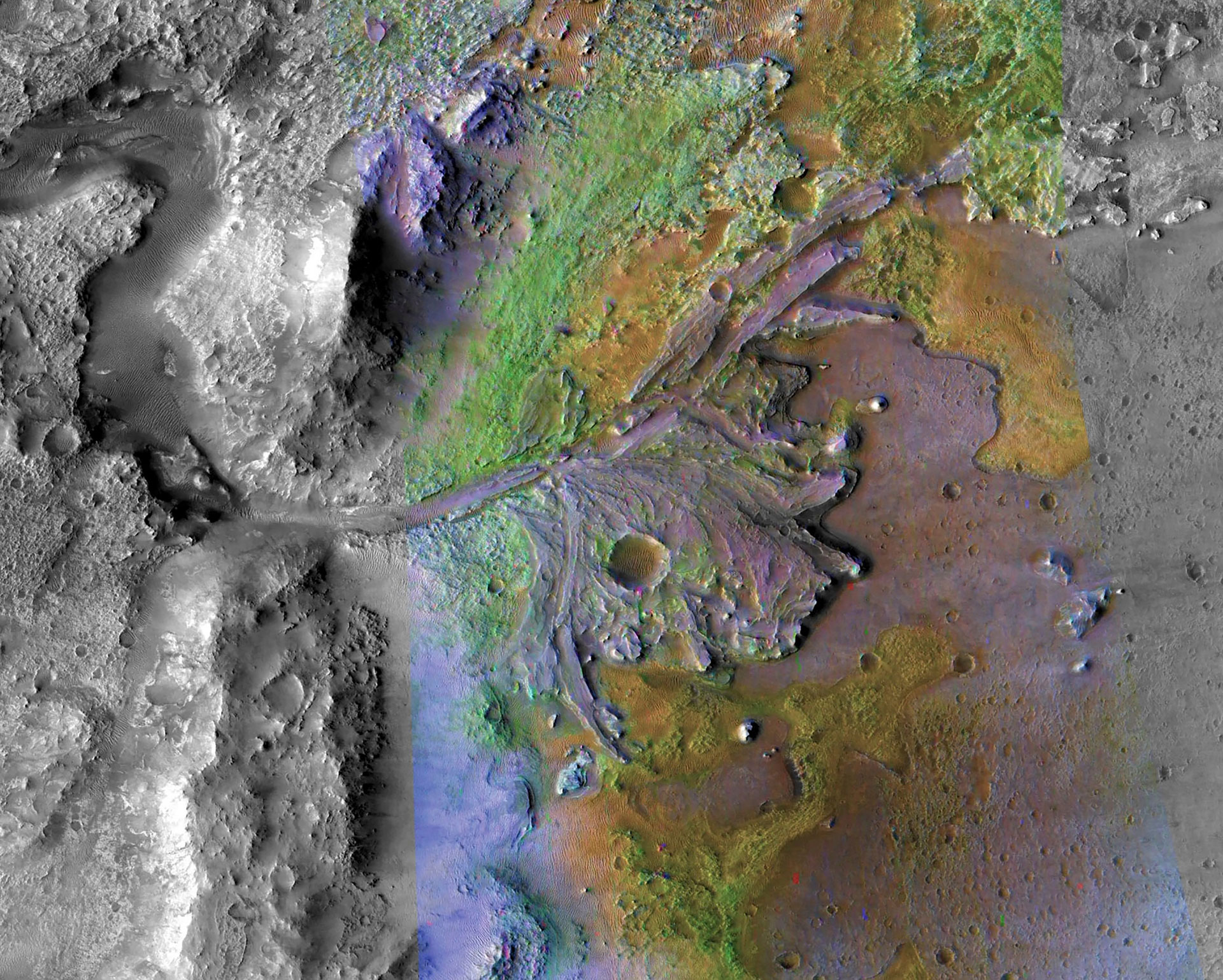
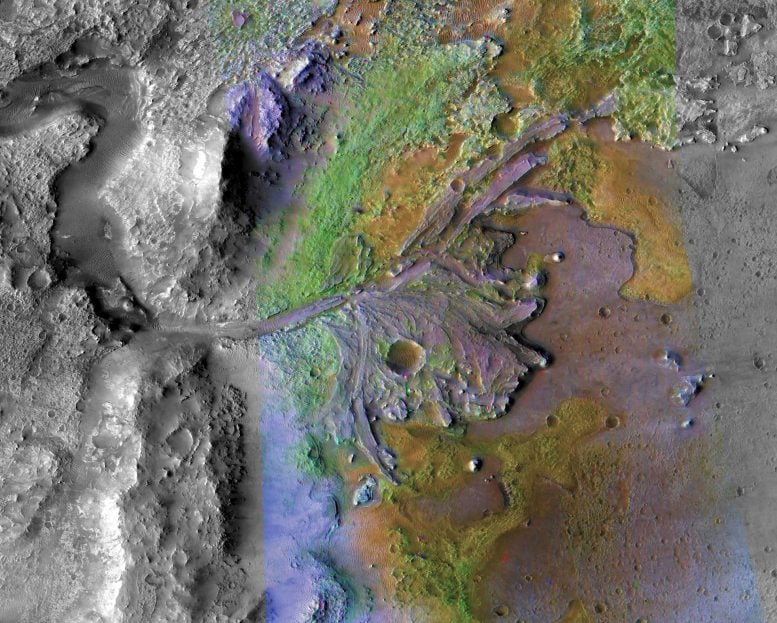
An aerial photo shows the remains of a delta where a water source once fed an ancient lake in Jezero Crater on Mars. Image source: NASA/JPL-Caltech/Arizona State University
Ground-penetrating radar reveals environmental changes over the ages and raises hope that soil samples bear traces of life.
- Ground penetrating radar on board NASA's Mars The Perseverance rover has confirmed that Jezero Crater, formed by an ancient meteorite impact north of the Martian equator, once contained a vast lake and river delta.
- Over the ages, sediment deposition and erosion within the crater shaped the geological formations visible on the surface today.
- The discovery of lake sediments raises hope that traces of life can be found in soil and rock samples collected by Perseverance.
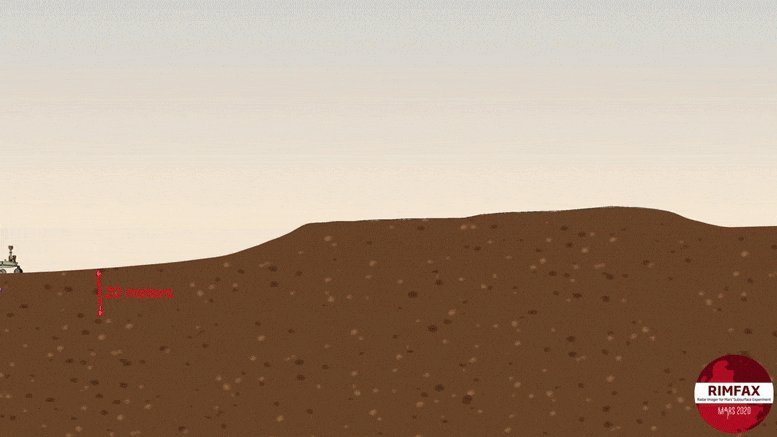
Animation showing the RIMFAX instrument on NASA's Mars Perseverance rover obtaining ground-penetrating radar measurements across the contact between the crater floor and the delta in Mars' Jezero Crater. Credit: Yubin Kim, David Page, UCLA
If life exists on Mars, Perseverance's verification of lake sediments at the base of Jezero Crater raises hope that traces can be found in the crater.
In a new research published in the magazine Advancement of scienceled team University of California And the University of Oslo It appears that at some point, the pit filled with water, depositing layers of sediment on the floor of the pit. The lake then shrank and the sediments carried by the river that fed it formed an enormous delta. As the lake dissipated over time, the sediments in the crater eroded away, forming the geological features visible on the surface today.
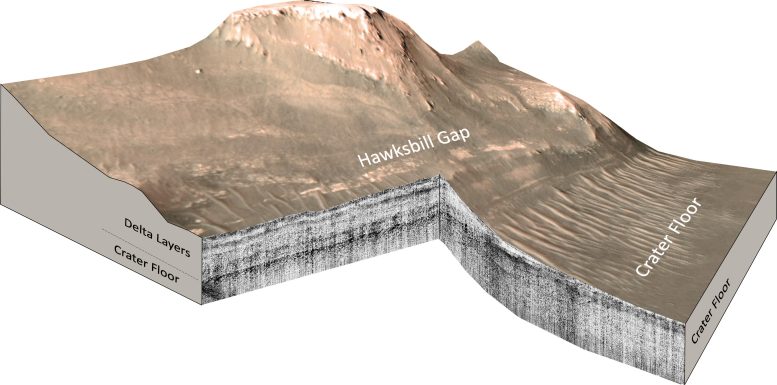
Mars Perseverance Rover RIMFAX Ground-penetrating radar measurements of the Hawksbill Gap area in Jezero Crater Western Delta, Mars. Hawksbill gap. Image credit: Sven-Erik Hamran, Tor Berger, David Page, University of Oslo, UCLA, JPL, NASA.
The radar indicates that periods of deposition and erosion occurred over eons of environmental changes, confirming that inferences about the geological history of Jezero Crater based on images of Mars obtained from space are accurate.
David Page said: “From orbit we can see a range of different deposits, but we cannot say with certainty whether what we are seeing is their original state, or whether we are witnessing the end of a long geological story.” Professor of Earth, Planetary and Space Sciences at UCLA and first author of this paper. “To know how these things formed, we have to see beneath the surface.”
AI-interpolated video from NAVCAM images from NASA's Perseverance rover as it transits below the western Jezero delta from Cape Nucchak to the crater floor of Sol 641. Image credit: Lior Rubanenko, Emily Cardarelli, Justin McKee, David Page, University of California, California Laboratory Institute Jet Propulsion Technology, NASA
The rover, about the size of a car and carrying seven scientific instruments, has been exploring the 30-mile-wide crater, studying its geology and atmosphere and collecting samples since 2021. Perseverance's soil and rock samples will be returned to Earth. By a future expedition and studying it for evidence of past life.
Between May and December 2022, Perseverance rocketed from the crater floor into the delta, a vast expanse of 3-billion-year-old sediment that, from orbit, resembles river deltas on Earth.
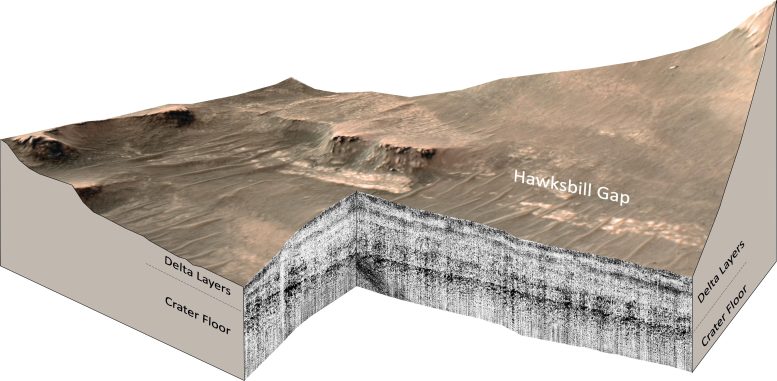
Mars Perseverance Rover RIMFAX Ground-penetrating radar measurements of the Hawksbill Gap area in Jezero Crater Western Delta, Mars. Image credit: Sven-Erik Hamran, Tor Berger, David Page, University of Oslo, UCLA, JPL, NASA.
As the rover headed toward the delta, PerseveranceRadar imaging of an experiment under the surface of Mars, The RIMFAX instrument fired radar waves downward at 10-centimeter intervals and measured reflected pulses from depths of about 20 meters below the surface. Using radar, scientists can see the base of the sediment to reveal the upper surface of the floor of the buried pit.
Years of research using ground-penetrating radar and testing RIMFAX on Earth have taught scientists how to read the structure and composition of subsurface layers from their radar reflections. The resulting subsurface image shows rock layers that could be interpreted as highway cuts.
“Some geologists say that radar's ability to see below the surface is a bit of a cheat,” said Page, a deputy principal investigator at RIMFAX.
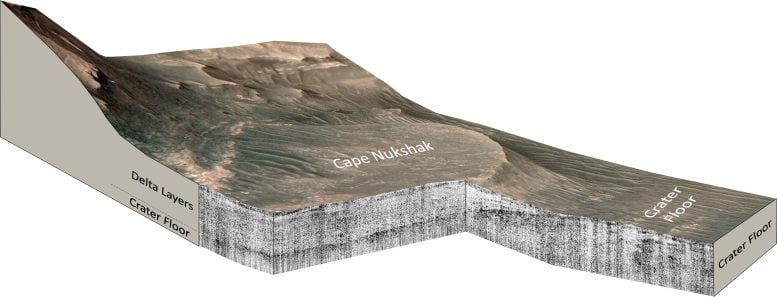
Mars Perseverance Rover RIMFAX Ground-penetrating radar measurements of the Cape Nookshak area in Jezero Crater Western Delta, Mars. Image credit: Sven-Erik Hamran, Tor Berger, David Page, University of Oslo, UCLA, JPL, NASA.
RIMFAX imaging revealed two distinct periods of sediment deposition sandwiched between two periods of erosion. The floor of the crater beneath the delta is not uniformly flat, suggesting a period of erosion occurred before lake sediments were deposited, UCLA and the University of Oslo reported. Radar images show that the sediments are regular and horizontal, just like sediments deposited in lakes on Earth. The presence of lake sediments had been suspected in previous studies, but was confirmed by this research.
A second period of sedimentation occurred when fluctuations in lake level allowed the river to deposit a broad delta that had previously extended far into the lake, but had now eroded back near the river mouth.
“The changes we see preserved in the rocky record are driven by large-scale changes in the Martian environment,” Page said. “It's great that we can see so much evidence of change in such a small geographical area, allowing us to extend our results to the entire crater size.”
Reference: “Ground-penetrating radar observations of the contact between the western delta and the floor of Jezero Crater, Mars” by David A. Page, Sven-Erik Hamran, Hans E. F. Amundsen, Tor Berger, Patrick Russell, Riva Kakaria, Michael T. Mellon, Sigurd Ede, Len M. Carter, Titus M. Casademont, Daniel C. Nunes, Emily S. Shoemaker, Dirk Pletteimer, Henning Dybvik, Sanna Holm-Alomark, and Briony H. N. Horgan, January 26, 2024, Advancement of science.
doi: 10.1126/sciadv.adi8339
The research was funded by NASA, the Norwegian Research Council, and the University of Oslo.

“Web maven. Infuriatingly humble beer geek. Bacon fanatic. Typical creator. Music expert.”





More Stories
Scientists confirm that monkeys do not have time to write Shakespeare: ScienceAlert
SpaceX launches 23 Starlink satellites from Florida (video and photos)
A new 3D map reveals strange, glowing filaments surrounding the supernova